Animals are undeniably Dodge. Wild animals abound in the forest, fields and wetlands at the nature center. On hikes, families often come upon wild turkey toms, glimpse red-winged blackbirds in the cattails, or spy the tiny tracks of mice in the snow. Students on field trips can gaze through clouds of honeybees and trail white-tailed deer through the woods. Dodge preschoolers peer back at the bright eyes of coyotes, captured on their trail camera. These wild encounters make memories and enhance nature learning.
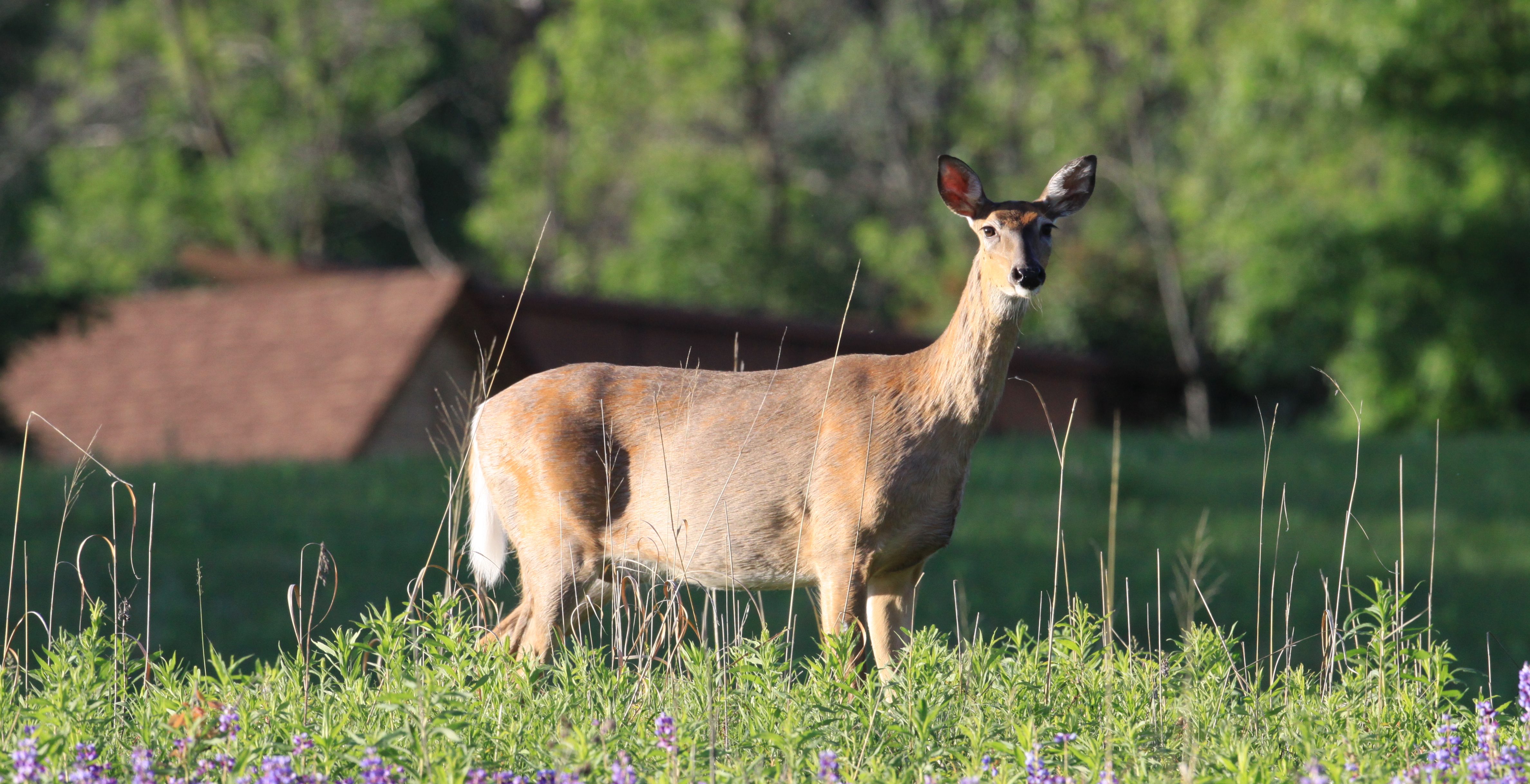
A white-tailed deer in the prairie, a common sight at Dodge.
But it’s the educational animals that Dodge staff care for—that live in the barn or the preschool or the Voight Raptor Mews—that often leave the most lasting impression.
“The chain reaction starts with that first animal encounter,” says Pam Welisevich, naturalist and animal care coordinator. “They care about the animal, so they’ll care about the habitat, and that leads to the broader spectrum of environmental issues.”
When people see Dodge’s educational animals up close, when they touch them or see eye-to-eye, they form a personal connection. And then they become invested in big, worldwide concerns: wildlife conservation, habitat loss, climate change, and sustainable agriculture.
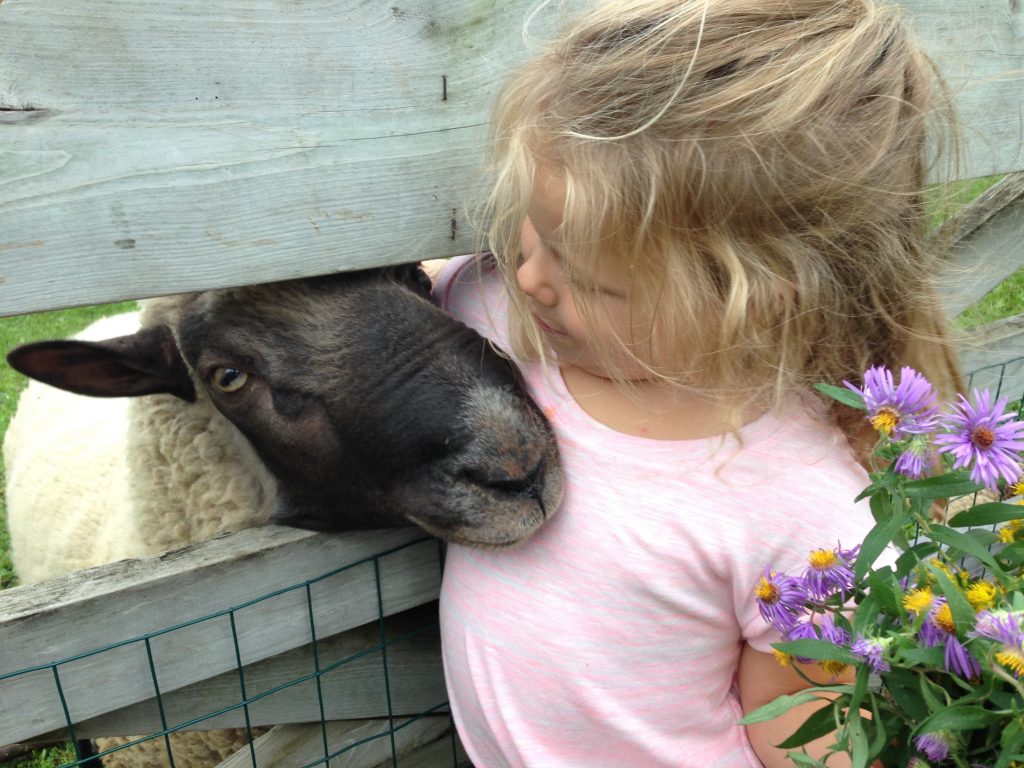
A young student embraces a friendly sheep on the farm.
Dodge keeps a range of animals to foster learning. Three birds of prey—a bald eagle, barred owl, and red-tailed hawk—were all injured in the wild and unable to be fully rehabilitated. They spark conversations about the threats facing wild birds, like lead poisoning. The farm is populated by rare, critically threatened breeds of pigs, goats and sheep. The Lab is lined with tanks of reptiles and amphibians—and a flying squirrel that sleeps the day away.
Asked about their bonds to the animals they care for, Dodge staff were quick to name the one (or ones) most near and dear to their hearts. One might expect to hear about wide-winged raptors or galloping gray horses, but they all made more grounded choices.
Case in point: naturalist Mick Garrett’s choice for his favorite educational animal. His pick sticks quite close to the earth.
Handsome hognose
Mick has a magic trick. With one particular animal on his arm, he can move a roomful of people from scared to sympathetic.
“I love doing snake programs because a good percentage of people are scared,” he says. “I’ve had whole classes afraid and the chaperones tear out of the room.”
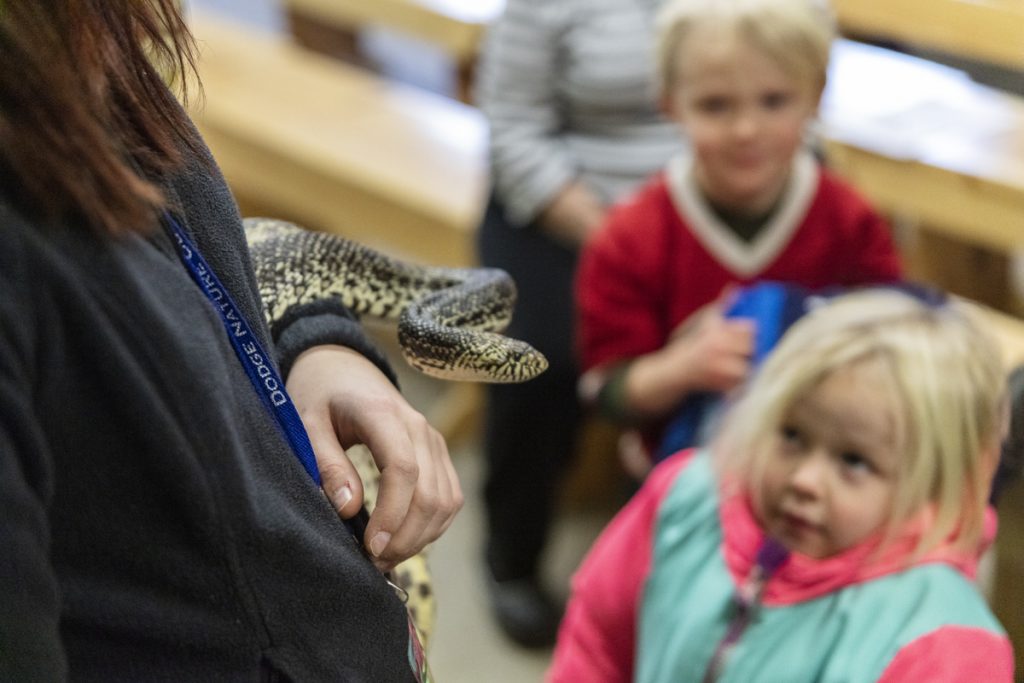
Bowtie, Dodge's resident Bull Snake, gets up close to a few curious kids.
He was in downtown St. Paul once, presenting a nature program in the skyway, when a woman passing by saw the snake he was holding. She turned and ran—straight into a plate of glass. (She was OK). That visceral response is why Mick often starts his snake presentations by telling a story from his childhood.
One day when he was in 2nd or 3rd grade, his mom started screaming about a snake in the garden. She was deathly afraid of snakes and made Mick climb atop the picnic table. “She wouldn’t even let my legs dangle over the edge of the table,” Mick remembers. “It wasn’t safe until my dad killed the snake with a shovel.”
That part of the story usually earns an audible “awwwwww” from his audience. The atmosphere in the room starts to switch from fear to sympathy.
People are conditioned to be afraid of snakes, he says. They’re told snakes are slimy and evil. Mick was told that too as a child. So, he started reading. He learned reptile skin is dry and scaly. A snake sticks out its tongue to smell. Far more snakes are killed by people, than people are killed by snakes.
“I realized my parents were wrong,” he says. “All they had was the fear, not the knowledge.”
Not that he blames them or anyone else who shares their distaste. “But don’t let fear control you, especially to the point that you kill snakes,” he says. “It’s better to have knowledge and understanding.”
All through the story, Mick has held a snake in his hands. Most often, it’s the Eastern hognose snake (Heterodon platirhinos), a native of Minnesota. The distinctive upturned scale on their snout lends them their name and the ability to root into sandy soils.

The upturned snout is a distinctive feature of the hognose snake. The cloudy eyes indicate it will soon shed its skin.
He asks his class, “Has it done anything wrong? Hurt me? Been mean to me?” They shake their heads.
“Look at its cute, plumpy nose,” he says in a high OMG voice. That often seals the deal with his students. In a matter of minutes, he has taken them from screaming to sympathy–even empathy–for this animal.
And then he asks an even more powerful question: Does anyone want to touch the snake? Hands shoot the ceiling. “Fifteen minutes earlier that never would’ve happened,” Mick says. “And often, for nearly the whole class, it’s the first snake they’ve ever touched.”
He always gives kids options, especially when it comes to an animal they fear. They get to choose whether to look with their eyes, touch with one finger, touch with more of their hand—or even hold the animal, if there’s time and it’s safe to do so.
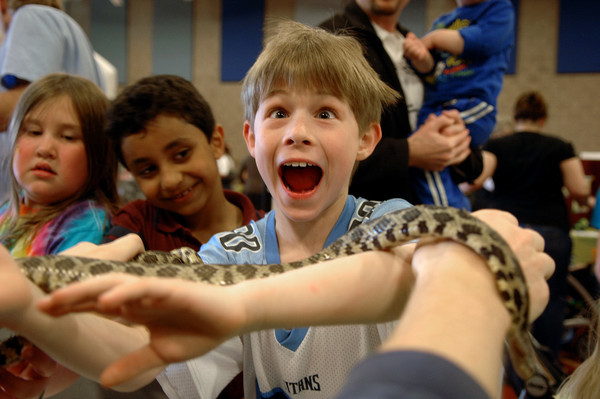
A student excitedly holds one of Dodge's snakes.
At the close of his presentation, Mick returns to his childhood tale, telling kids their enthusiasm for the natural world can make a big impact. If his own parents were to encounter a snake today, Mick knows they would use that shovel to move the snake to a safe place. In every class, brave students inspire teachers, chaperones and parents to reach out and touch the snake.
“Very hesitantly, but they’ll touch a snake for the first time,” Mick says. “They tell me, ‘I have to learn.’”
That’s the power of knowledge over fear, he says. A life lesson, inspired by an animal.
Goat showboat
Pam’s pick for her favorite program animal is, in her words, “an obvious choice.” That’s because she invested a lot in this animal’s survival. Not to mention, he’s pretty cute.
Cornelius is a petite 3-year-old San Clemente Island goat. He was one of triplets born to a mother that couldn’t nurse. Despite best efforts to save his siblings, they died. Cornelius hung in there, thanks to round-the-clock attention. Everyone at the veterinary clinic fell in love with him and offered physical therapy sessions to strengthen his back legs. He made progress, only to decline again. In a last-ditch effort, he was put on antibiotics and finally turned the corner.
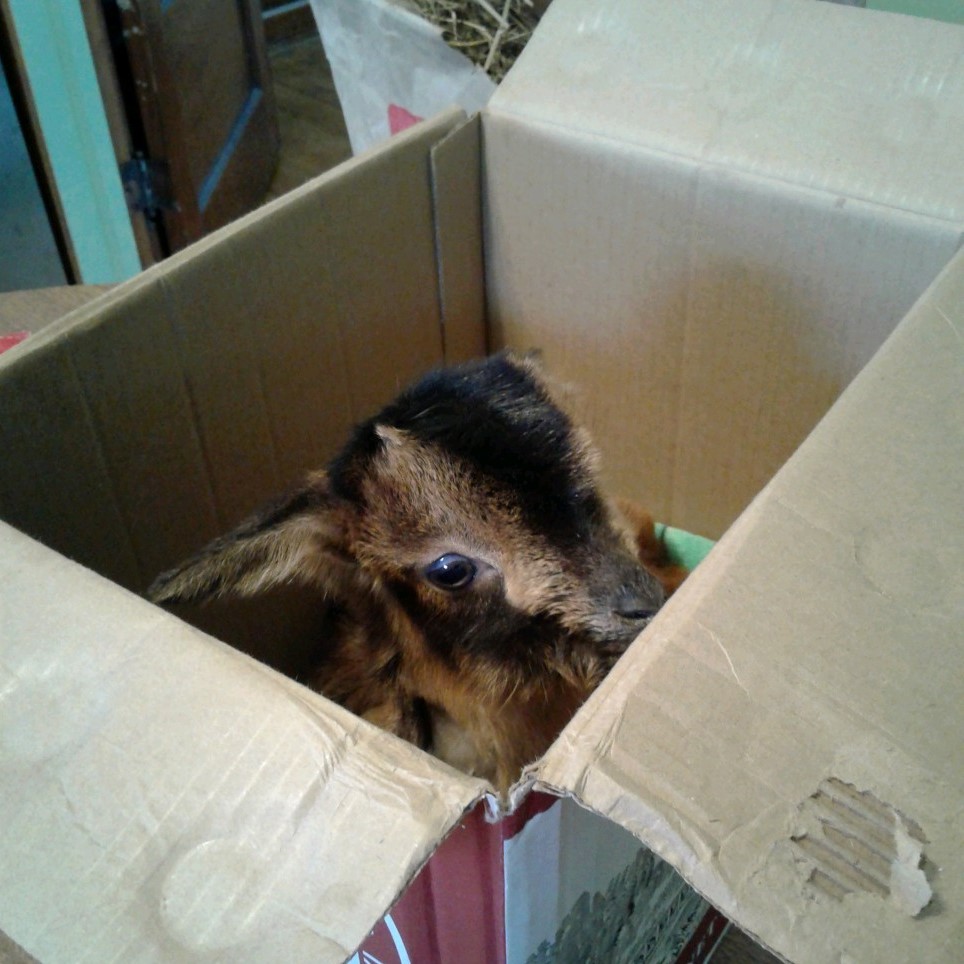
Cornelius peers out of his box on the way to the vet.
He was saved through the concerted effort of a big, devoted team. Pam and her husband Farmer Don Oberdorfer cared for him in their own home. The Naturalist Fellows bottle-fed him at 10 p.m. The veterinary clinic donated its services.
Today, Cornelius is a friendly fixture at the farm. He loves to greet kids at the fence line, and gently nibble their mittens and clothes. But Pam says his “star-studded personality” really shines at events out and about in the community.
In a pet show at the Cottage Grove Strawberry Fest, he pranced to the crowd’s cheers and claps, securing the title of Best Exotic Animal. He loves to pucker up for a goat kissing booth at A Night for Nature, Dodge’s annual benefit, and fundraisers for Heritage E-STEM Magnet School in West St. Paul.
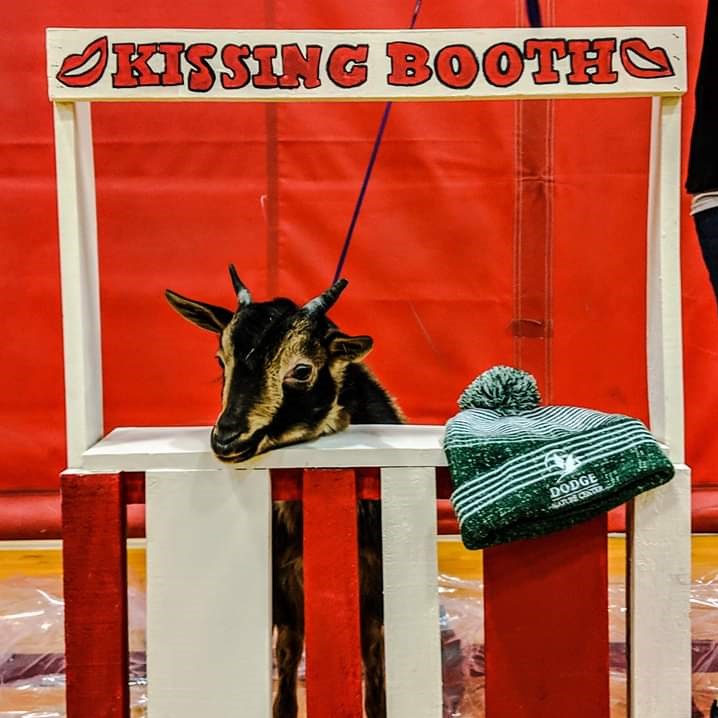
Cornelius at Heritage E-STEM Magnet School waits patiently for students and teachers in the kissing booth.
“He’s such a survivor,” Pam says. “He’s a miracle and a poster animal for Dodge.”
Favored flock
When Ella Taggart joined the Dodge staff as Farm Assistant in spring 2019, she had more experience with plants than animals. But it was March when she started, peak of the spring birthing season on the farm, and she didn’t have time to be anxious.
“I just jumped right in,” Ella says. “Being thrown into it was really the only way to go about it.”
Taking her time during farm chores attuned her to animal behavior in the barn, pastures and coops. One type of animal took interest in her, too, following her around while she worked and entertaining her with their antics.
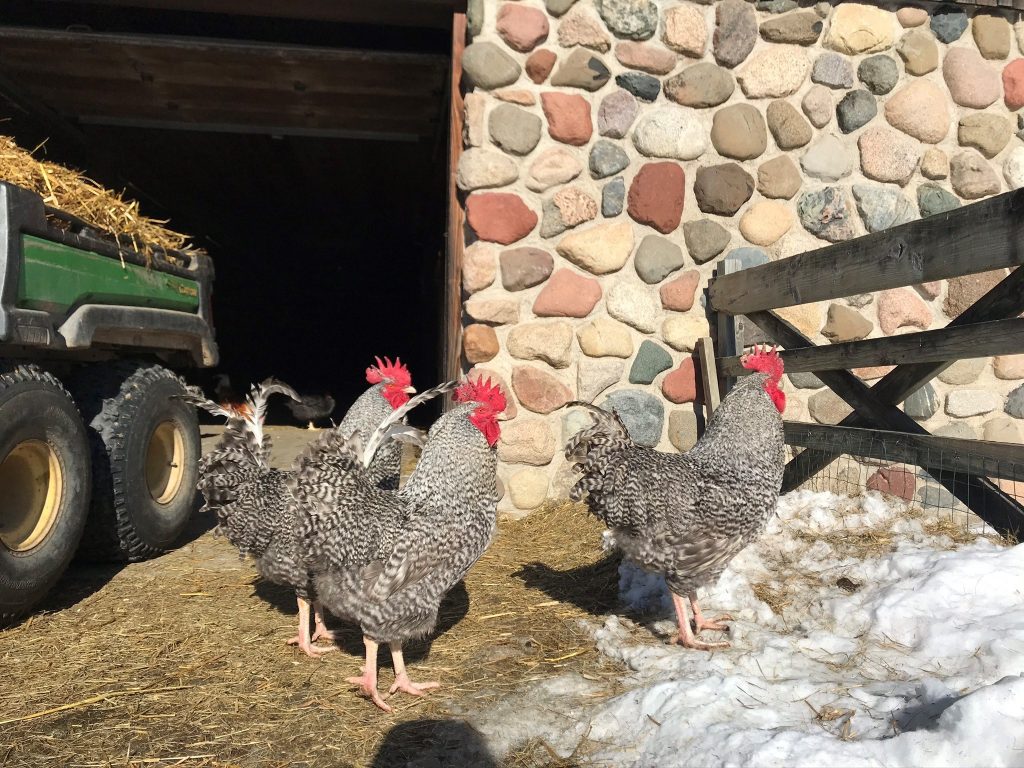
A few friendly roosters help supervise the daily farm chores.
“They’re kind of funny, but also annoying,” she says of chickens, her favorite farm animal. “They’re constantly in the way, but they like to be involved.”
Because of their numbers, colors or brash behavior, chickens are often the first animal that people notice when they arrive at the farm.
“Some people are confused as to why they’re out and about,” Ella says. “[They] ask us if we know the chickens are loose.” It’s an opportunity for her to explain that chickens play different roles at Dodge. The free-range chickens eat the bugs in the barnyard; the others are tucked away in the coop, laying eggs.
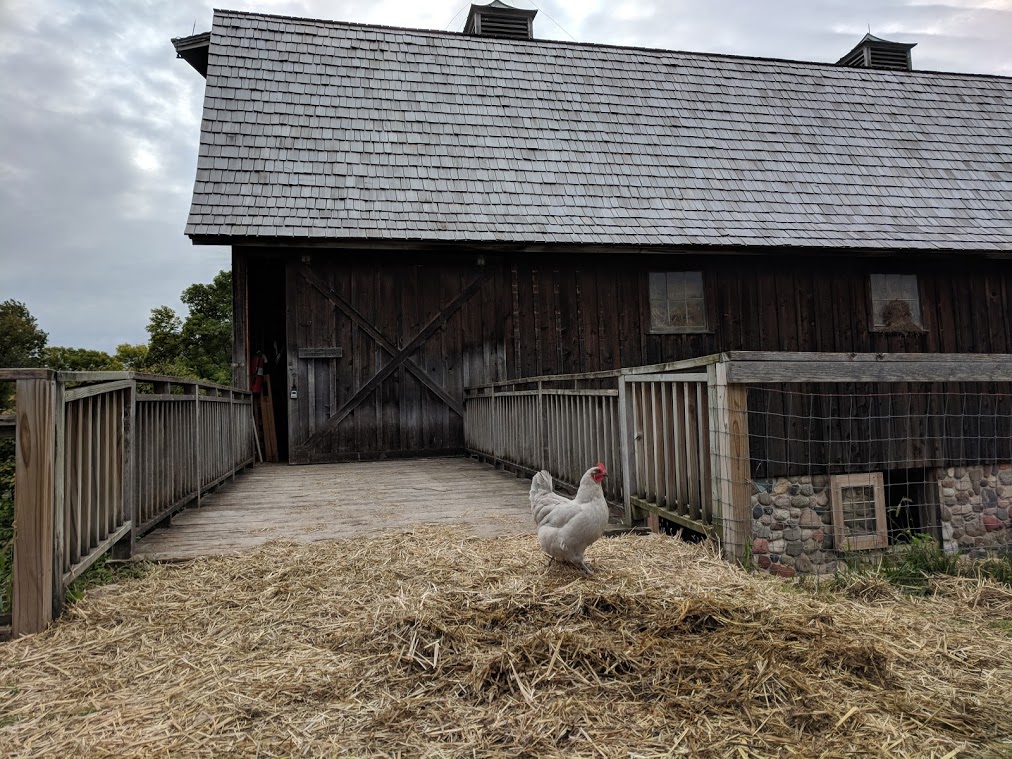
A single chicken roams the barnyard.
Perhaps Ella holds the answer to the proverbial question: Which comes first, the chicken or the egg? She witnesses the full life cycle of chickens, starting when hens squawk out their 15-minute “egg songs” as they lay. When the eggs of every hue hatch, yellow or black chicks emerge. As they grow, their feathers change to their breeds’ specific coloration and personalities develop.
When Ella cleans out the coops or adds compost to the community garden plots, she knows she’s contributing to an important aspect of Dodge’s educational mission.
“We’re really lucky that Dodge is so close to the cities,” Ella says. “People can come out here and see where their food [like meat and eggs] comes from, that there’s more to it than just going to the grocery store.”
Cherished chicken
But the barnyard isn’t the only place to see a chicken in action. Dodge Nature Preschool’s playground also has a very special hen in residence.
Preschool teacher Kristenza Nelson says classroom animals, like Eddie the chicken, are an essential aspect to the school.
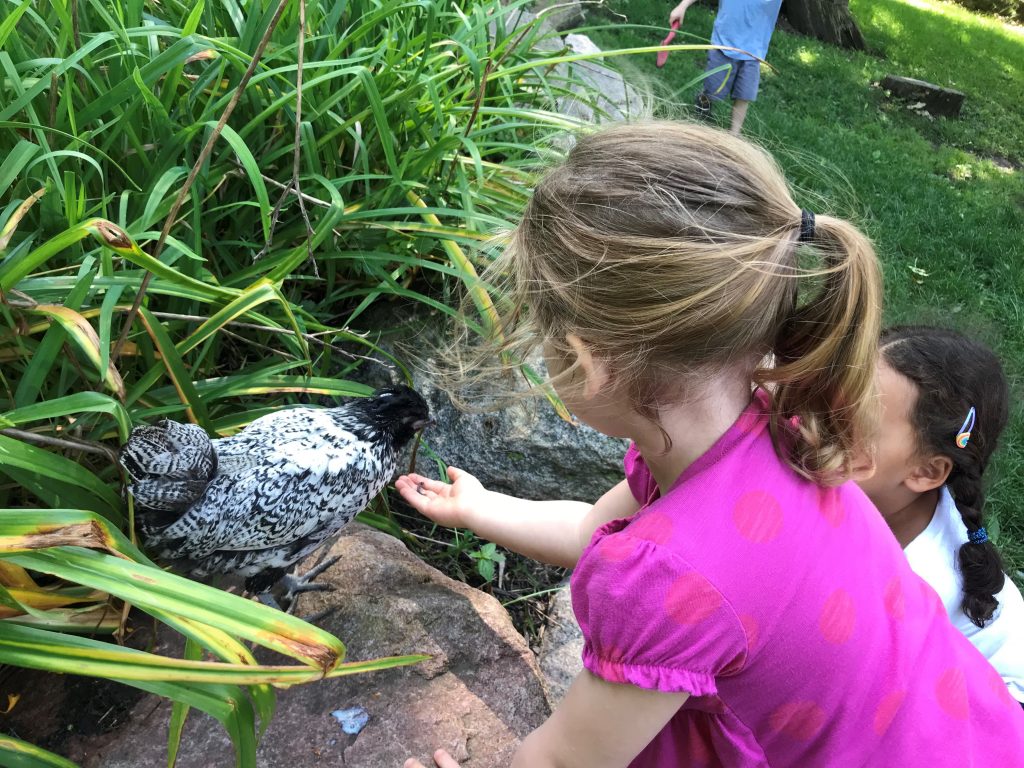
A few preschoolers offer Eddie a snack in the schoolyard.
“Some 3-year-olds separating from their parents for the first time may feel some anxiety,” she says. “Eddie can help ease that transition. We see that time and time again as children quickly become engaged with her.”
When the classroom turtles are frightened, they pull their necks and heads into their shells. Kristenza says kids develop empathy when they identify with scared or hesitant animals. When a child takes the risk of reaching out to a new animal, they feel courageous for conquering their fear. Young helpers feel capable when they feed or shelter an animal.
A year ago, Eddie was hand-picked by the Dodge farmers to be a friendly addition to the preschool. At first, the small black-and-white chicken was thought to be a rooster. Then she laid her first egg. The name stayed, as a shortened form of Edith.
The student-chicken bond began day one of the school year. “Eddie is brand-new to the preschool, just like you,” Kristenza told her students. “We are her flock.”
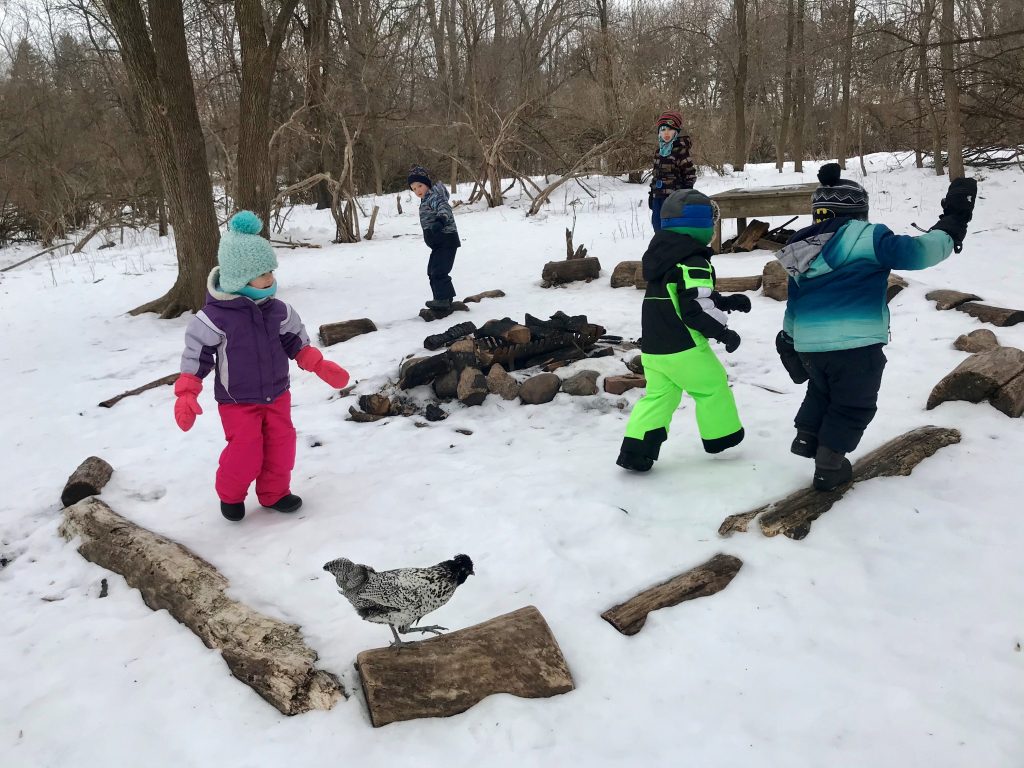
Eddie joins in on the fun at Best Camp Ever, even in snowy and cold conditions!
At their age, preschoolers sometimes reject other’s overtures of friendship. But Eddie never does that. She provides connection and companionship for all.
And everyone helps provide for Eddie’s wellbeing, bringing her straw and buckets of food. They learn not to chase her, but to lure her in with freshly dug earthworms.
She’s inspired reams of preschooler drawings and a massive “Eddie Town” built from wood blocks. She tags along for field trips to Best Camp Ever, an outdoor classroom not far from the Sugar Shack. Her birthday party was student-organized, and complete with decorations, candles and all her favorite foods: meal worms, blueberries and suet cakes.
On occasion, preschoolers collect Eddie’s eggs and scramble them for snack time. That sparks conversations about whether grocery store eggs have chicks inside them or not (and the role that roosters play).
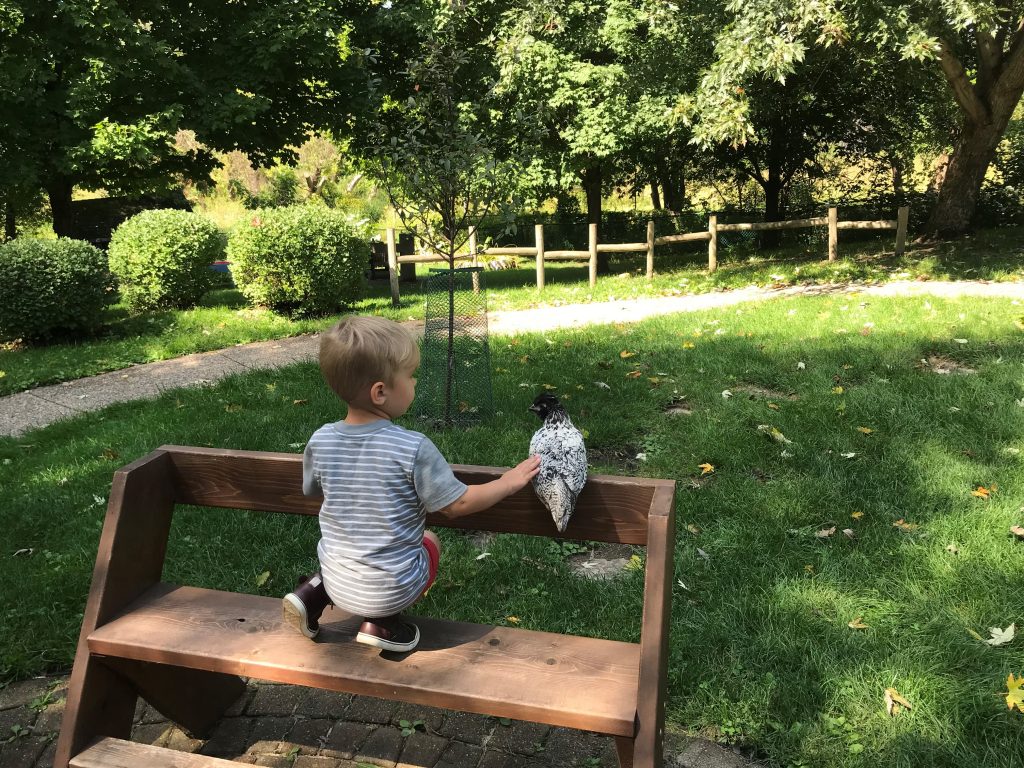
A preschooler and Eddie sit together on a bench enjoying the outdoors.
“She provides for endless curriculum,” Kristenza says. “Everybody gets to love Eddie, almost like an aunt. She’s everyone’s chicken.”
And that’s true of all Dodge’s educational animals. They truly provide endless curriculum, and they’re everyone’s animals.